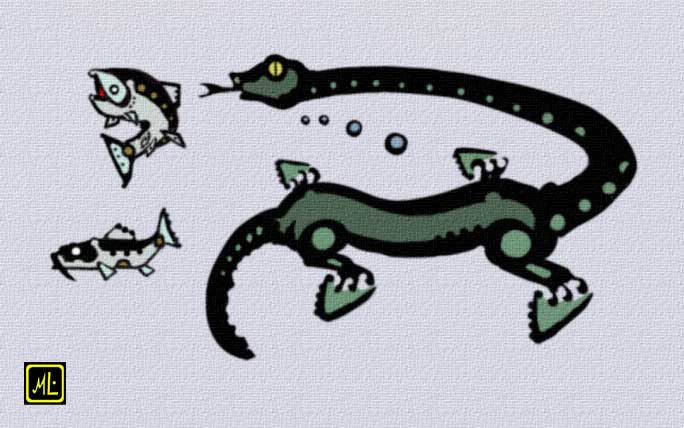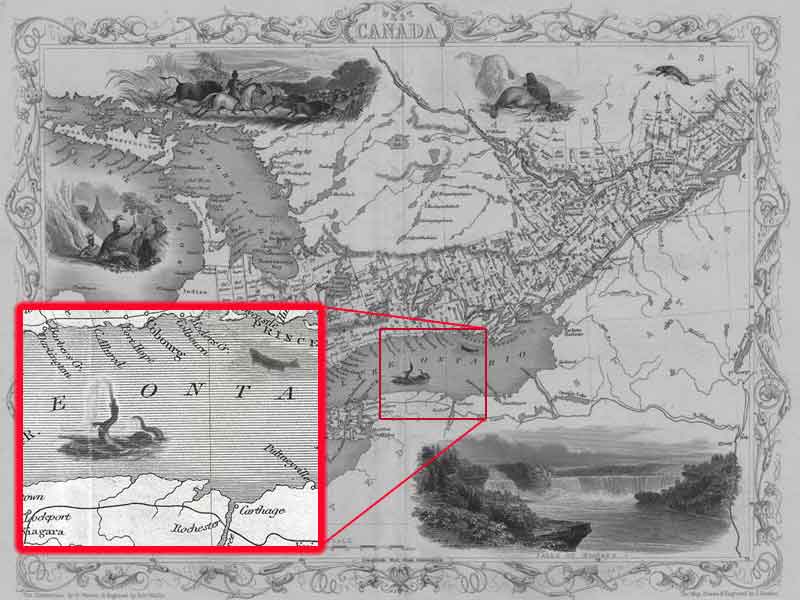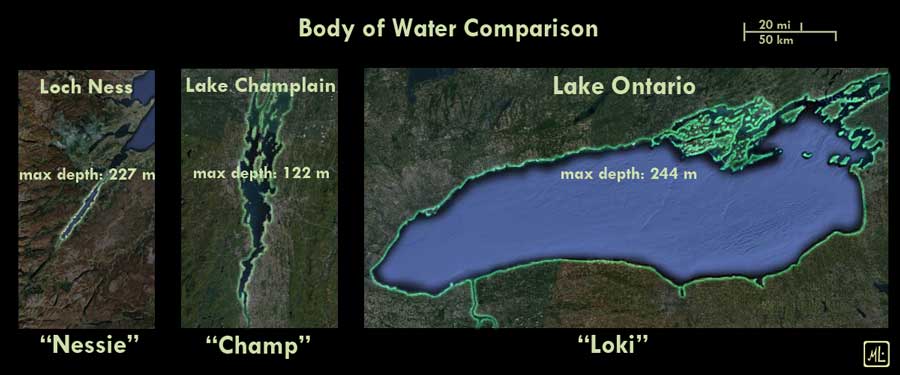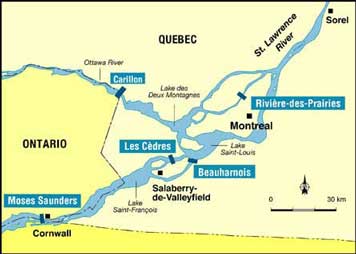
Myth, Legend and Reality.
A myth is a traditional tale, typically ancient stories dealing with supernatural beings, ancestors, or heroes that serves as fundamental types in the worldview of a culture.
As such the First People, before the European arrivals, told tales of an entity in the great Lake Ontario. There lived a being, composed of many creatures, that churn the waters and guard its' denizens. The myth described it, as having the head and neck of the water snake, body of an otter and the powerful tail of a muskrat. And huge, as long as several men hand-in-hand. And powerful as it paddles faster than any war canoe.

The purpose of myths is to account for the origins of something, explain aspects of the natural world, or delineate the psychology, customs, or ideals of society. They tried to understand the unknown within their cultural concepts. Regardless of ones inclination to their point of view, it is safe to say something in the lake needed to be explained.
A legend is similiar to a myth, it is a traditional tale handed down from earlier times but believed to have a historical basis, an objective credibility, a rooted reality.
The world of the First People changed forever as the Europeans arrived. In 1608, as a wilderness scout, working on behalf of the French explorer Samuel de Champlain, Etienne Brule became the first European to see Lake Ontario. Brule lived a life of extraordinary exploits and larger-than-life adventures. His trail-breaking travels to Lake Ontario paved the way for Champlain. He lived amongst Champlain's Huron allies, learning their languages, myths and customs. Brule witness one of their "myth"; it reminded him of creatures from sea mariners tales...of sea serpents.
The illiterate Brule left no written record of his journeys, but Champlain's journals and illustrations detail some of his discoveries and encounters. Though some were omitted due to the sheer absurdity and possibly embellishment, one was not ...for Champlain became a witness too. A myth has become a legend.
When more explorers ventured into this new frontier, they too became part of the folklore. In 1670's Rene-Robert Cavelier, Sieur de la Salle aboard the Frontenac, a small barque that became Lake Ontario's first sailing ship, exclaimed "Un grand serpent au milieu du lac". De la Salle has a history of reporting things for his own gain but bragging about a monster in the middle of the lake is not to his advantage.
Lake Ontario had a population of Atlantic Salmon native to its waters, which supported sustenance and thriving commercial fisheries. Trade on the lake was substantial. And by the shores, growing settlements.
In 1763, the British acquire the French Lower (Quebec) and Upper (Ontario) Canadas. The Americans came soon, then eventually Canadians. As the Age of Sail arrived, in the 19th century, occasional sightings by fishermen and sailors would bear witness to the elusive creature; it became part of folklore legend...and tall tales?

The legend fades...as "civilization" and industrialization took hold.
Until the late 19th century, the fisheries were sustainable. But it was eliminated through the combined effects of the environmental degradation of spawning streams, raw sewage from growing towns and cities, industrial wastes that empty into the lake, and massive over-fishing. Atlantic Salmon was one of the first fish species in Lake Ontario to disappear as a result of human activities.The fishermen, the prominent first hand witnesses of the creature, left with the collapse of the fishing industry and eventually that generation died off...and their tales. Quiet sailing trade ships were replace by noisy powered freighters; sailors no longer see any thing "extraordinary". Beside in these times of civilization, stories of sea monsters are for children and the ignorant. The growing sophistication of the world would ridicule or damn anyone with "fairy" tales. It's the Industrial Revolution, no time for myths and legends...just cold machines and coal fires.
The Resurgence of legends and myths, started across the ocean...in Scotland.
Modern interest in lake monsters was sparked on 22 July 1933, when George Spicer and his wife saw "a most extraordinary form of animal" cross the road in front of their car in Scotland, around Loch Ness.
The scientific community regards the Loch Ness Monster as a modern-day myth, and explains sightings as mistaken identifications of more mundane objects, outright hoaxes, and wishful thinking. Despite this, it remains one of the most famous examples of cryptozoology. That monster has been affectionately referred to by the nickname "Nessie".
In North America, this spur interest about Lake Champlain which straddles New York, Vermont and a bit of Quebec, it is home for their monster. It still receives considerable attention, as indicated by the name (Vermont Lake Monsters) and mascot of the state's minor league baseball team. Since the 1930's Loch Ness events, more "sightings" in this lake have occurred. It too has a nickname "Champ".
Not to be left out of the trend, renewed interests in the monster of Lake Ontario also slowly resurfaced. It too has a nickname which may have been derived from the acronym from an old title on a survey report of possible resident lake animals, Lake Ontario (K should be "C") Creature Identity list, its nickname is "LOKI".
Loki the Norse god is often called the Sly One, the Trickster, or the Shape Changer...in some way an appropriate name for this enigmatic creature of Lake Ontario.
But how can a creature evolve in such a body of water? Present-day Lake Ontario was born from the giant glacial lake known as Lake Iroquois. Water from the higher-level Lake Erie basin drained over the Niagara Escarpment, to the Lake Iroquois basin below. The ancient Lake, shaped like Lake Ontario, was larger and deeper.
Glacial ice had retreated first from the western end of the Lake Iroquois basin, sending its outlet flow south toward New York's Hudson River Valley. But when a massive plug of ice finally pulled away from the Thousand Islands (where it had been blocking flow in the basin's eastern end), Lake Iroquois surged through the newly-opened channel of the St. Lawrence River. Water levels in Lake Iroquois began to drop and the Lake's shoreline receded, beginning the long, slow birth of present-day Lake Ontario. This occurred about 12,000 years ago, as the "Wisconsin" ice age drew to a close.
As such all lifeforms, not just this creature, did not originated from the lake. All species found its way to the new home. This creature like the Atlantic salmon may have arrived from the sea via the St Lawrence River.
The river connects to the estuary of the Gulf of St Lawrence, it is a cornucopia of ecological productivity. Several species of sea turtles migrate to these region, along with 20 species of whales (one stay year round, the Beluga). Vast stocks of fishes, sharks and shellfishes were abundant and to some extent still is plentiful though today some species are endangered by over fishing and oil exploration.
What is it like?
Some basic characteristics of the animal must be determined before deciding if any particular environment can support it. This will allow for a just plausibility.
It's a large creature but not monstrous, people think sea monster as in Godzilla-BIG...no. The size of the animal, based on Indian and old fisherman folklores, is about 5 meters; they compared its size to a travel canoe or fishing dory in length. It is huge but smaller than a killer whale, which is about 7 to 9 meters.
Those same folklores (witness tales) says it's fast and agile. The small head and long neck would indicate a small fish diet and maybe bottom forager. And being large yet shy, shows a timid reclusive nature because an aggresive animal of this size would lead to more sightings and exposure. In the open ocean this creature would be midrange in the food chain, both predator and being preyed. Sharks and killer whales would be a threat. It is a survivor from another age, now in a narrow niche.
It would exhibits a suite of anatomical characteristics believed to be associated with a life in cold waters, including an extensive covering of brown adipose tissue, temperature independent swimming muscles and counter-current heat exchangers between the large flippers and the core body. These features are not new, they exist in present cold water dwelling sea turtles.
Reproduction is another issue. Does it behave like aquatic reptiles and lay eggs on a beach? The largest sea turtle, the Leatherback, has a length of 1.7 m and can just haul itself on shore to bury eggs. The creature, Loki, being 5 m would be stranded. More likely it would be ovoviparous. The term used to describe an organism that retains eggs inside the body, where the young hatch within, then seemingly give birth to live young. Before birth, the female holds the embryos in the "womb" without a placenta. Instead, the embryos absorb nutrients from a yolk sac.
Lake Ontario...a credible home? Is it still?
The description of Loki resembles that to Nessie and Champ. If one believes there existence then does Lake Ontario match or better those creature's environments? Is Lake Ontario more likely a place with resources and space, where a viable community may be sustained? Below is a chart of their respective homes. They are to the same scale.

Lake Ontario is vast and never ice over. The water temperature is cold but overall relatively consistent year round. The range for the creature extends right up to a natural barrier, Niagara Falls. Yet there are negative points to living in this body of water.
The quality of Lake Ontario has changed since the 1900's and species have vanished and many endangered. The other Great Lakes, especially Lake Michigan and Erie, empties their waste and toxin into Lake Ontario before exiting to the St Lawrence River. Unfortunately even that has been changed.

In 1842, the first canal and dike work for the Beauharnois Canal was begun. Then construction of the Beauharnois hydroelectric dam/generating station, with inauguration in 1932. Similiarly, Les Cedres dam also was built in that time period. creating Lake Saint-Francois from the backing up of the St Lawrence.
The latest blockage to the river is the Moses Saunders dam built between 1954 and 1958, it created Lake St Lawrence as a result for hydro-electric generation. Basically a complete block and control of the flow to the sea. This includes flooding and accumulation of pollution which have effected fish populations on the river (and lake). Northern Pike, Walleye, Muskellunge, Lake Sturgeon and American eel have been affected. Lost of spawning grounds as well are believed to have contributed to drops in their populations.
If Loki required migration to and from the sea, it is trapped. Toxin and waste are still great issues with Lake Ontario. Its food resources has further diminished as fish species are under pressure. In the past, in legends and myths, it lived and thrived...does it now? Or have it joined the long vanished Atlantic salmon? Maybe...but it's a big lake...and Loki and its kind are survivors.
![]()